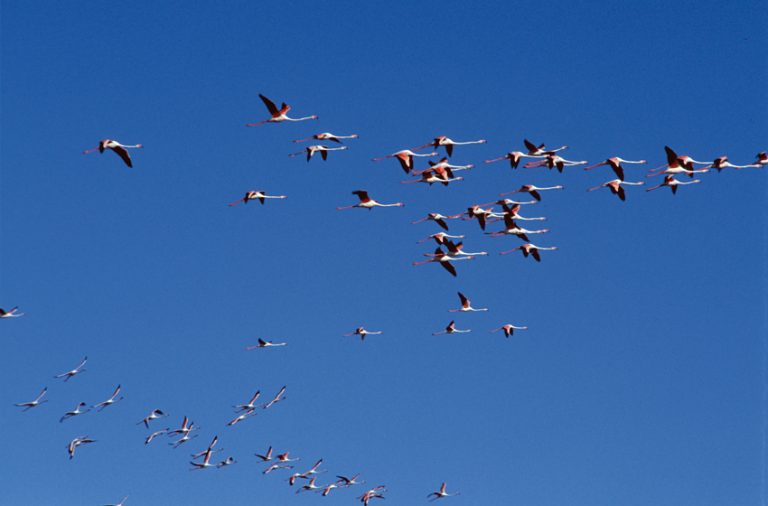
Etosha pan – the trek of the flamingos
Text by Hu Berry When reptiles shed their scales and replaced them with feathers about 200 million years ago, the forbears of flamingos rose with

Photograph Annabelle Venter
From the Winter 2025 issue
Etosha National Park, renowned for its stark beauty and vast white salt pan, is also home to one of Africa’s most extraordinary and seldom-seen wildlife spectacles: the mass breeding of flamingos. In this shimmering and seemingly inhospitable expanse, both Lesser and Greater Flamingos have adapted to thrive, bringing colour, sound and movement to the landscape when seasonal rains transform the pan into a shallow lagoon.
Flamingos are among the oldest surviving birds, with an evolutionary history stretching back nearly 200 million years. Their long legs, sinuous necks and unique upside-down bills are specialised for feeding in saline, nutrient-rich waters. Their honking calls, similar to those of geese, reveal their close relation to other waterfowl, but flamingos remain in a class of their own for spectacle and endurance.
The Etosha Pan, spanning nearly 5,000 km 2 , is one of the few remaining sites in Africa where flamingos can breed successfully. These birds are highly selective and may wait years for the right conditions to reproduce. But when the rains fall at the right time, something remarkable occurs.
During these rare breeding events, the pan becomes a cradle of life. Thousands of flamingos gather after performing elaborate courtship rituals at coastal lagoons such as Walvis Bay. These displays involve head-flagging, synchronised marching and sudden wing salutes. At sunset, they take to the skies in long skeins, navigating by the stars as they head inland to Etosha. There, they use their specially adapted beaks to build conical nests from wet clay and lay a single egg.
Voice imprinting ensures that even in enormous groups of nearly identical, downy chicks, each parent can locate and feed its own offspring. Guided by their parents, the chicks march across the drying pan in huge groups known as kindergartens. They walk for weeks, covering up to 80 kilometres, often burdened by crusted clay, stalked by predators, and entirely dependent on their parents’ commitment.
In 1971, one of the most spectacular breeding seasons occurred, when more than a million flamingos arrived at Etosha. Of the 30,000 chicks hatched that year, an estimated 25,000 survived the gruelling journey to water. It was a powerful demonstration of endurance and the tenacity of nature.
The flamingos of Etosha are more than a visual marvel. They are living relics of a prehistoric world, symbols of resilience, and reminders of the fragile balance that sustains life in Africa’s wild places. TN

Text by Hu Berry When reptiles shed their scales and replaced them with feathers about 200 million years ago, the forbears of flamingos rose with